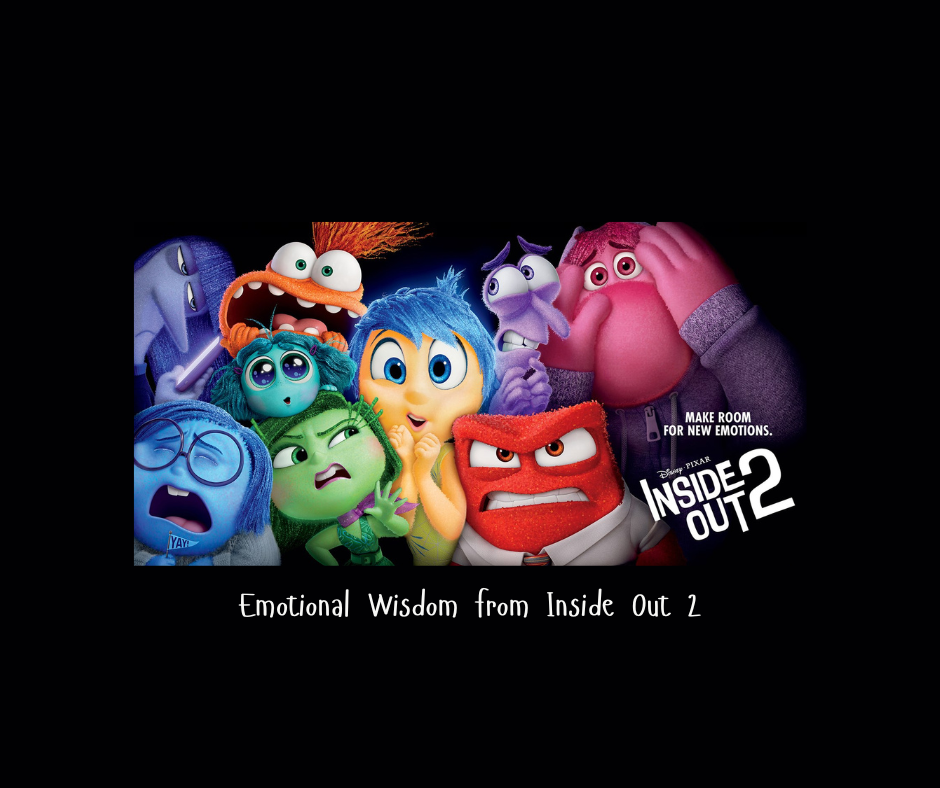Inside Out 2, the sequel to Pixar’s beloved original, brings us back into the mind of Riley, now a teenager. As she navigates the tumultuous waters of adolescence, we meet new emotions—Anxiety, Envy, Ennui, and Embarrassment—joining Joy, Sadness, Anger, Fear, and Disgust. These characters provide a rich tapestry for exploring mindfulness and emotional intelligence.
Understanding and Accepting New Emotions
In Inside Out 2, Riley’s new emotions reflect the added complexity of teenage life. Anxiety, Envy, Ennui, and Embarrassment are common feelings during adolescence, and the movie vividly portrays these emotions.
- Anxiety: Represented by a frazzled, energetic character, Anxiety ensures Riley is prepared for potential negative outcomes. In real life, anxiety can be overwhelming, but recognizing it is the first step. Mindfulness teaches us to observe our anxiety without judgment, allowing us to understand its triggers and manage its intensity.
- Envy: This small but persistent emotion is always yearning for what others have. By acknowledging envy, we can transform it through gratitude practices, focusing on what we do have rather than what we lack.
- Ennui: The epitome of teenage boredom and apathy, Ennui reminds us of the importance of finding meaning and engagement in our daily lives. Mindfulness helps us reconnect with the present moment, making even mundane tasks more meaningful.
- Embarrassment: This blushing, burly character wants to hide, reflecting our fear of social judgment. Embracing our vulnerability through mindfulness can reduce the power of embarrassment, helping us to be kinder to ourselves.
Mindful Awareness and Emotional Balance
Throughout the movie, Riley learns to balance her emotions, a crucial skill in mindfulness. Emotional balance doesn’t mean suppressing feelings but rather allowing them to coexist harmoniously.
- Identify and label emotions: Research shows that labeling our emotions can reduce their intensity (Lieberman et al., 2007). Riley’s journey illustrates the importance of identifying and naming what we feel, a core mindfulness practice.
- Breathing exercises: Simple mindful breathing can help manage strong emotions. Techniques like deep breathing or box breathing can activate the body’s relaxation response, bringing calm during emotional storms.
Navigating Anxiety with Mindfulness
Anxiety plays a significant role in Inside Out 2, symbolizing the heightened awareness and fear of the unknown that comes with growing up.
- Mindfulness meditation: Studies have shown that mindfulness meditation can significantly reduce symptoms of anxiety (Hofmann et al., 2010). Encouraging regular practice can help manage anxiety, providing a sense of calm and control.
- Grounding techniques: When Anxiety takes over, grounding techniques, such as focusing on the senses (what we can see, hear, touch, taste, and smell), can bring us back to the present moment, reducing panic.
The Power of Self-Compassion
Riley’s struggle with self-compassion is a central theme. She often judges herself harshly, a common issue during adolescence.
- Self-compassion practices: According to Dr. Kristin Neff, self-compassion involves treating ourselves with the same kindness we would offer a friend (Neff, 2003). Practicing self-compassion can mitigate the effects of self-criticism, leading to better mental health.
- Affirmations: Positive affirmations can reinforce self-compassion. Phrases like “I am enough” or “I deserve kindness” can be powerful tools in rewiring negative self-talk.
Embracing Change and Growth
Riley’s transition from childhood to adolescence mirrors the natural changes and growth we all experience. Embracing these changes with mindfulness can ease the transition.
- Acceptance: Acceptance is a key aspect of mindfulness. Embracing change rather than resisting it can reduce stress and promote growth. Riley’s journey teaches us the value of accepting our evolving selves.
- Reflective journaling: Keeping a mindfulness journal can help track changes in our thoughts and feelings, providing insight and promoting acceptance.
Embracing Emotional Mindfulness
Inside Out 2 offers a profound look into the complexity of our emotions and the importance of mindfulness in understanding and managing them. By recognizing and accepting new emotions, balancing our feelings, navigating anxiety, practicing self-compassion, and embracing change, we can cultivate a mindful approach to our emotional landscape. Let Riley’s journey inspire you to explore your own inner world with curiosity, compassion, and courage.
References:
Hofmann, S. G., Sawyer, A. T., Witt, A. A., & Oh, D. (2010). The Effect of Mindfulness-Based Therapy on Anxiety and Depression: A Meta-Analytic Review. Journal of Consulting and Clinical Psychology, 78(2), 169–183.
Lieberman, M. D., Eisenberger, N. I., Crockett, M. J., Tom, S. M., Pfeifer, J. H., & Way, B. M. (2007). Putting Feelings Into Words: Affect Labeling Disrupts Amygdala Activity in Response to Affective Stimuli. Psychological Science, 18(5), 421–428.
Neff, K. D. (2003). Self-Compassion: An Alternative Conceptualization of a Healthy Attitude Toward Oneself. Self and Identity, 2(2), 85–101.

Leave a Reply